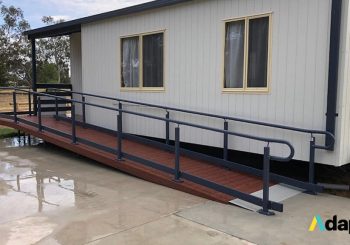If you are considering getting a disability ramp installed on your property, the structure must be built in line with the DDA guidelines.
The Australian Standards for Access and Mobility
In order to ensure safe and dignified access to buildings and facilities for people with disabilities, the Australian Government has set guidelines for the safety precautions and design requirements of access solutions.
These standards are to be used during the design, manufacture, installation and inspection of access solutions such as Adapta’s ramp, rail and step access kits. The standards are regularly reviewed and renewed to ensure they keep pace with new technologies and changing needs of people with disabilities.
We Value Safety
Safety is our top priority at Adapta, so all of our ramps, rails and step access kits are designed and engineered according to the standards set in the Building Code of Australia. For added convenience, our designs are pre-approved, which means you can simply install your kit without having to have it inspected and approved by a governing body.
We Are Ready to Listen
Our team at Adapta are always on hand to talk through our standards of safety our help you understand the Australian Standards for Access and Mobility ramps that are relevant to your unique project.
For those wanting a more in-depth understanding, all of the relevant standards are available for purchase in PDF format and are detailed below.
These Standards are for those who are undertaking new building work and detail the general requirements set out by the Building Code of Australia to ensure people who use wheelchairs, people with ambulatory disabilities and people with sensory disabilities can safely and conveniently access buildings.
AS 1428.1-2009
Design for access and mobility – General requirements for access – New building work
Purchase AS 1428.1-2009
(http://infostore.saiglobal.com/store/Details.aspx?ProductID=1378917)
AS 1428.1-2009 Amendment 1 – 2010
(http://infostore.saiglobal.com/store/Details.aspx?productID=1441460)
The Design for Access and Mobility standards outline enhanced or additional requirements for the design of buildings and facilities for access for people with disabilities and is to be used in conjunction with part 1.
AS 1428.2-1992
Design for access and mobility – Enhanced and additional requirements – Buildings and facilities
Purchase AS 1428.2-1992
(http://infostore.saiglobal.com/store/Details.aspx?ProductID=227276)
These standards specify the design requirements applicable to new building work to provide access to people with disabilities and the specific requirements for children and adolescents.
AS 1428.3-1992
Design for access and mobility – Requirements for children and adolescents with physical disabilities
Purchase AS 1428.3-1992
(http://infostore.saiglobal.com/store/Details.aspx?ProductID=227283)
This Standard sets out requirements for the design and application of tactile indicators for new building work, to ensure safe and dignified mobility of people who are blind or vision impaired.
AS/NZS 1428.4.1:2009
Design for access and mobility – Part 4.1: Means to assist the orientation of people with vision impairment: Tactile ground surface indicators
Purchase AS 1428.4.1-2009
(http://infostore.saiglobal.com/store/Details.aspx?ProductID=1380327)
The design for access and mobility communication for people who are deaf or hearing impaired standards outline the requirements for the design, application and testing of assistive listening systems.
AS 1428.5:2010
Communication for people who are deaf or hearing impaired
Purchase AS 1428.5-2010
(http://infostore.saiglobal.com/store/Details.aspx?ProductID=1396046)
FULL SET OF AS1428,
PARTS 1, 2, 3, 4 & 5
Purchase full set AS 1428.1-5




